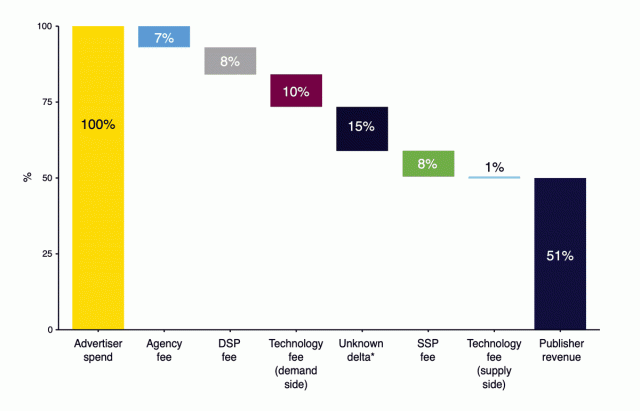An explosive new report released this week lays bare the true cost & complexity of the programmatic supply chain.
The detailed, in-depth report, compiled by the ISBA’s Performance and Programmatic Steering Group, in conjunction with PwC’s Marketing & Media Assurance team and using log-level data from throughout the programmatic supply chain, paints a damning picture of the current state of the programmatic marketplace.
For a lot of people in the ad tech ecosystem, a lot of this will come as no surprise. Opaque ad tech fees and murky supply chains are so commonplace that they even have their own shorthand – the ad tech tax. However, many media owners will rightly be astounded to learn that for every pound spent by an advertiser on media, 49p evaporates along the supply chain before ever reaching the end seller, leaving only 51p for the people creating the value – the publishers.
Two key supply-side areas immediately jump out of the report and will give media owners pause for thought:
1) SSP FEES AVERAGED 2% HIGHER THAN CONTRACTED
The typical loss of value in the supply chain attributed to supply side platforms (SSP) was 14%. Meaning 14p of the advertiser pound is witheld by the SSP as their fee. This was 2% higher than the contracts laid out, which could suggest SSPs taking higher fees than contractually agreed. The report is quick to point out that “these variations are at an impression level; they might be corrected via reconciliations.”
However, without regular log level analysis (which the report suggests is unfeasible due to inconsistencies across the level of data shared by platforms), it’s impossible to tell if SSPs take-rates are what they say they are.
2) 15% OF ADVERTISER SPEND IS SIMPLY LOST & UNACCOUNTED FOR
The tech tax is pervasive from end to end in the programmatic advertising supply chain but one would be forgiven for assuming that every hop along the chain is at least accounted for.
However, the report found that 15p of every pound spent by the advertiser simply vanishes. This equates to one third of the supply chain costs being unattributable, even when analysing transparent, disclosed programmatic models.

The study doesn’t lay the blame for this unaccounted revenue, but it does suggest several potential scenarios:
- Limitations in data sets, necessitating occasional estimations
- DSP or SSP fees that aren’t visible in the study data
- Post-auction bid shading
- Post-auction financing arrangements or other trading deals
- Foreign exchange translations
- Inventory reselling between tech vendors; or other unknown factors.
Our interpretation is that the delta can be attributed, in part, to all of these scenarios. However one stands out as something we identified early on: inventory reselling between tech vendors.
It is not uncommon for SSPs to buy and resell inventory to each other many times before it is ultimately offered to the advertiser. This often results in several unnecessary hops, with the ad tech tax being re-applied at every stage. It is for this reason that Trade House Media enacted the policy wherein we don’t operate with any vendor that doesn’t provide unique and essential value to the supply chain. To this end, we have cancelled contracts with any resellers and we were an early adopter and vocal supporter of the sellers.json and OpenRTB supply chain object initiatives, which we have rolled out across our entire platform.
CONCLUSION
It’s important to note that this report is put together by profit-making entities. While that doesn’t necessarily detract from it’s key points, it’s worth keeping in mind that—as with reports released by ad fraud vendors—there is an incentive to make a big deal out of what is a non-issue. It’s also important to note that there is no clear method of defining where the 15% is being lost. The report lays out its theories but to reiterate, there could be malfeasance or simple, benign data errors along the chain.
The second point to note is that the value created through the programmatic supply chain is oftentimes incremental and not revenue that publishers would have had direct access to otherwise. This incremental uplift is the value offered by the programmatic ecosystem and there is rightly a cost to the service they provide.
What this report demonstrates, now more than ever, is that the programmatic supply chain is vast and in dire need of optimisation. With hundreds of vendors attempting to entangle themselves into the supply chain, businesses like Trade House Media are positioned to manage these inherent inefficiencies in the market with a single point of sales, finance collections and account management.
Years after the first programmatic impression was served with the promise to simplify the trading of digital ad spend, the industry has never been further from that ideal.
Download the full study on the ISBA website: ISBA Programmatic Supply Chain Transparency Study
